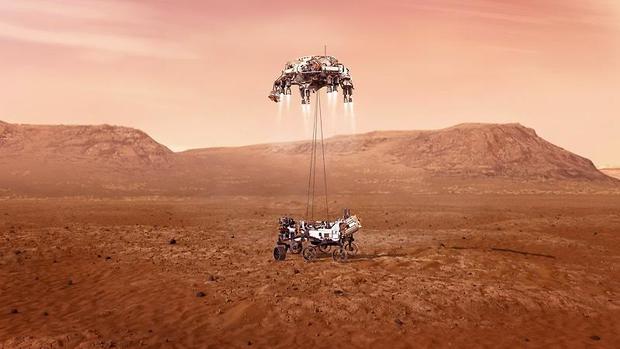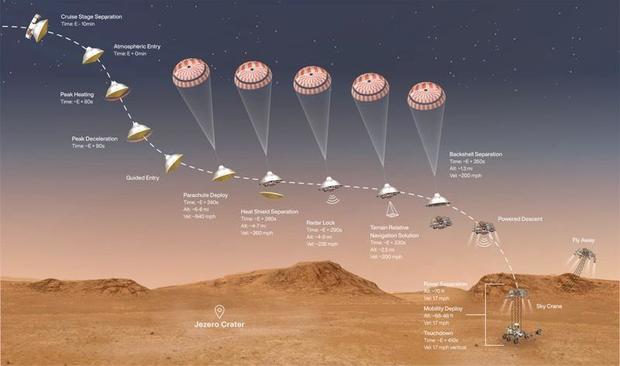Watch Live: NASA's Perseverance rover landing on Mars
Update: Perseverance landed successfully on Thursday — read the latest story here. Our earlier coverage is below.
NASA's Perseverance Mars rover closed in on the red planet after a journey of 293 million miles, hurtling toward a nail-biting seven-minute descent to touchdown Thursday. The mission is an unprecedented attempt to find signs of past microbial life at the site of an ancient Martian river, delta and lakebed.
Mission managers at NASA's Jet Propulsion Laboratory in Pasadena, California, said that the spacecraft was healthy and flawlessly executing its final approach to Jezero Crater as it readied for a high-speed descent that engineers only half jokingly refer to as "seven minutes of terror."
Asked Wednesday what the odds might be for a successful landing, deputy project manager Matt Wallace said the sheer complexity of the 2,260-pound rover, the heaviest and most sophisticated ever sent to Mars, makes it difficult to predict.
"We've got two million lines of software code running hundreds of thousands of electronic parts, miles of copper conductors, we've got more than 70 pyrotechnic devices that all have to fire, closed-loop guidance and navigation control systems that really have to operate with sub-second precision for all this to work," he said.
"There (are) no go backs. There (are) no retries. It's a difficult and dangerous part of the mission. ... I think we've done everything we can to make it successful. And we'll see how it goes tomorrow."
Seven months after its launch from Cape Canaveral, the $2.4 billion rover, encased in a flying saucer-like aeroshell and protected by a blunt heat shield, will slam into the top of Mars' discernible atmosphere at 3:48 p.m. EST.
Hitting the thin, mostly carbon dioxide "air" at a blistering 12,000 mph, the spacecraft will rapidly decelerate, enduring heat shield temperatures as high as 2,370 degrees as it slows to just under 1,000 mph within about four minutes.
At that point, at an altitude of about seven miles and a velocity of around 940 mph, a 70.5-foot-wide parachute will unfurl in the supersonic slipstream, slowing the spacecraft to just 200 mph by the time it reaches an altitude of 1.3 miles.
"There's a lot of concentrated risk in that supersonic parachute opening," said Allen Chen, the engineer in charge of the rover's entry, descent and landing. "It's a very big parachute, the size of a Little League infield and it snaps open in about point-six seconds while going almost Mach 2 (twice the speed of sound)."
"But ... we actually did high-altitude supersonic testing (on Earth) this time as part of this project. So we have perhaps a little bit more confidence that this is going to work."
Dropping away from the parachute and backshell one minute before touchdown, the rover's rocket-powered "sky crane" descent vehicle will swoop to an altitude of just 70 feet or so, lowering Perseverance to the floor of Jezero Crater on quick-release tethers.
Because of the 127-million-mile gulf between Earth and Mars, it will take radio signals, relayed through NASA's Mars Reconnaissance Orbiter, 11 minutes to reach anxious flight engineers at JPL.
As a result, the success or failure of the rover's seven-minute descent will depend entirely on its ability to figure out exactly where it is in relation to its landing target and autonomously adjust its course as required to avoid steep cliffs, boulders, sand dunes and other mission-ending hazards.
Jezero Crater offers one of the best places on Mars to look for signs of past microbial life — but it's also the most challenging landing spot NASA has ever attempted to reach on Mars.
And it will all be over, one way or the other, in just seven minutes, well before flight engineers receive signals confirming the start of atmospheric entry. Hence the familiar references to "seven minutes of terror."
Looking for signs of past life
If Perseverance makes it down safely, the robot geologist will be poised to possibly answer one of the most profound questions in modern science: Are we alone? Or did life, however primitive, manage to evolve on another world and, by extension, might it exist on countless other worlds across the cosmos?
Jezero Crater was targeted because about 3.5 billion years ago it held a 28-mile-wide body of water the size of Lake Tahoe that was fed by a river cutting through the rim of the crater and depositing sediments in a fan-like delta clearly visible from orbit. Perseverance is targeting a landing on the floor of the lakebed just beyond the delta.
Engineers plan to spend about 90 days checking out the rover's complex instruments and systems. During the first month, they also plan to deploy and test a small 4.5-pound, $80 million helicopter — Ingenuity — that will attempt the first powered flight in the thin air of Mars, a "Wright brothers' moment" on another planet.
Another experiment will test the feasibility of extracting oxygen from the Martian atmosphere, technology that could help future astronauts produce their own air and rocket fuel. But the primary goal of the mission is to look for signs of past biological activity.
Equipped with a robot arm, a core-sampling drill and a suite of sophisticated cameras, rock-vaporizing lasers and other instruments, Perseverance will study lakebed deposits, venture across the delta and eventually make its away up to the ancient lake's shoreline, collecting promising samples along the way.
Selected rocks and soil will be placed in a complex internal carousel mechanism that will autonomously photograph, analyze and load them in lipstick-size air-tight tubes that eventually will be deposited, or cached, on the surface.
NASA plans to send another rover to Jezero later this decade to collect the samples, load them into a small rocket and blast them into Mars orbit where a European Space Agency spacecraft will capture and return them to Earth for laboratory analysis.
But first, Perseverance has to safely land.
"That is always a challenging feat for us, this is one of the most difficult maneuvers that we do in the space business," Wallace said. "Almost 50% of the spacecraft that have been sent to the surface of Mars failed. And so we know we have our work cut out for us tomorrow to get down to the surface safely at Jezero."







